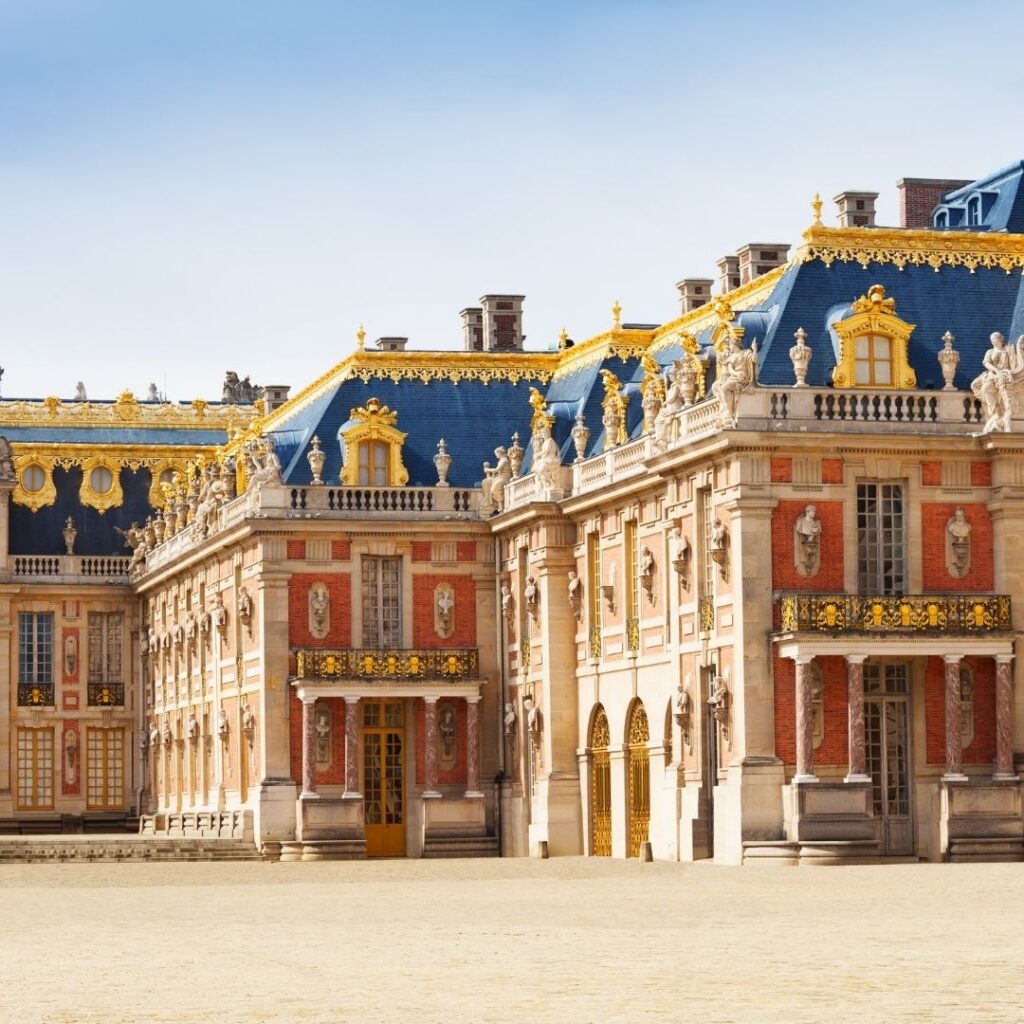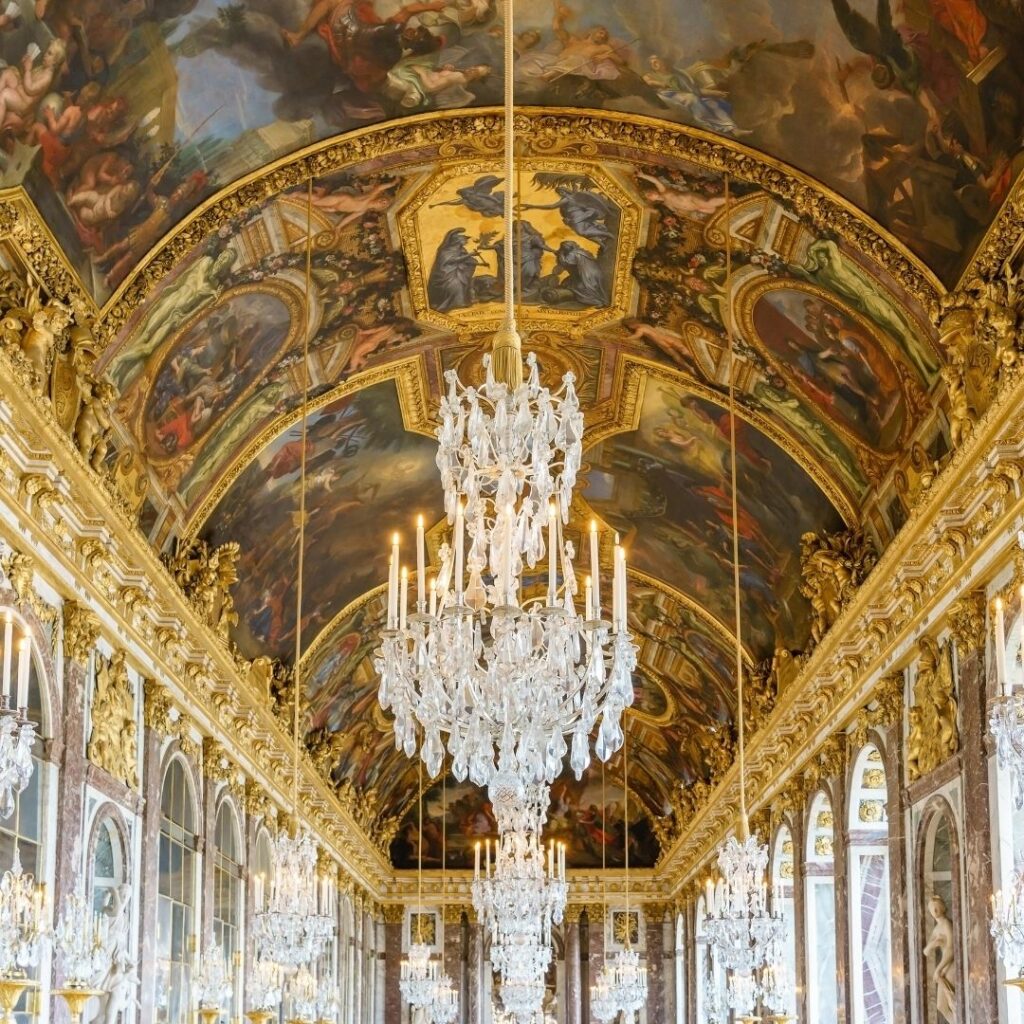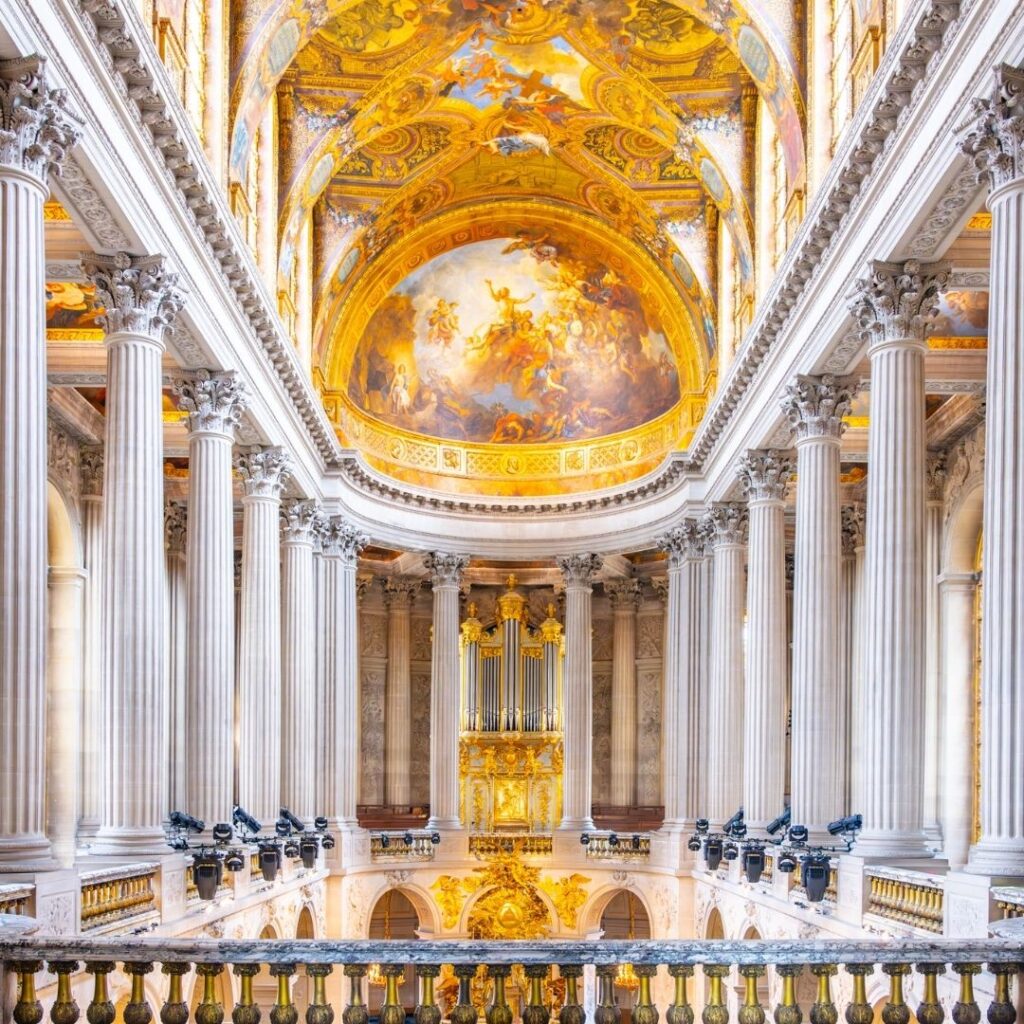A trip to Paris isn’t complete without visiting Versailles, the ultimate showcase of French royal opulence.
Just a short ride from the city, Versailles offers grand interiors, stunning gardens, and fascinating history. Whether you’re planning a day trip or an overnight stay, let’s make the most of your visit.
Disclosure: This post may contain affiliate links, meaning I may get a small commission if you decide to make a purchase through my links, at no cost to you.
Getting to Versailles
The easiest ways to reach Versailles from Paris are by train, guided tour, or private car. Here’s how to choose the best option for your trip:
By Train
- RER C Line: Ride to Versailles Château Rive Gauche station (10-15 minutes’ walk from the palace).
- SNCF from Montparnasse: Arrive at Versailles Chantiers station (20-30 minutes’ walk).
Guided Tours
Ideal for first-timers, there are so many options for guided tours that it can be hard to choose! Tours often include skip-the-line-access. Here are our picks:
- Large group tour that meets in Versailles before touring the palace
- Large group tour that meets in Paris and travels to Versailles by coach
- Small group tour that meets in Versailles before touring the palace and grounds
Private Tour and Driver
For a luxurious experience, book a private tour and driver for door-to-door service from your hotel in Paris and a customizable itinerary.
- Half-day private tour with a historian or art historian of the palace and gardens.
- Full-day private tour with a historian or art historian of the palace and gardens as well as the Queen’s Hamlet, Grand Trianon, and Petit Trianon.
Trains are affordable and efficient, but tours add insight and convenience.
Tickets and Passes for Visiting Versailles

Buy tickets in advance to avoid long lines and secure your preferred time slot.
Here’s a quick guide to your options:
- Palace Ticket: Includes the main palace and gardens (except during Musical Garden or Fountain show days).
- Passport Ticket: The best value and covers the entire estate, including the Trianon Palaces, Queen’s Hamlet, and garden shows.
- Paris Museum Pass: Includes palace entry but not Trianon Estate or garden shows. You’ll still need to reserve a timed slot online.
The gardens are free on most days, except during the Musical Fountains or Musical Gardens programs when a ticket is required.
A Brief History of Versailles
Versailles began as a hunting lodge for Louis XIII but was transformed into a royal masterpiece by his son, Louis XIV, the Sun King. From 1661 to 1715, the palace expanded into a symbol of absolute monarchy, hosting lavish celebrations and political events.
Successive monarchs, including Louis XV and Louis XVI, continued to enhance the palace. However, Versailles also became a symbol of royal excess. Its grandeur contributed to public unrest, culminating in the French Revolution and the fall of the monarchy.
Inside the Palace of Versailles
With over 2,300 rooms, Versailles can overwhelm first-time visitors.
Focus on these must-see highlights:
Hall of Mirrors

The Hall of Mirrors, Versailles’ most famous room, dazzles with 357 mirrors reflecting light from 17 arched windows.
Built to showcase the Sun King’s power, the room’s opulence is unforgettable.
- Historic Significance: The Treaty of Versailles, ending World War I, was signed here in 1919.
- Look Up: The vaulted ceiling, painted with scenes from Louis XIV’s reign, adds to the splendor.
Best Time to Visit: Early morning or late afternoon to avoid peak crowds.
The King’s State Apartments
The King’s State Apartments consist of seven rooms, each showcasing ornate ceilings, marble paneling, and elaborate tapestries.

Highlights:
- Hercules Room: Grand chandeliers and a massive Veronese painting.
- Salon of Apollo: The King’s formal throne room.
- Salon of War: Lavishly decorated with battle-themed sculptures.
Tip: Join a guided tour to unlock hidden stories and insights into royal life.
The Royal Chapel
Completed in 1710, the Royal Chapel blends Gothic inspiration with Baroque design.
This two-story chapel, with its towering columns and frescoed ceiling, hosted royal weddings, including the marriage of Louis XVI and Marie Antoinette.
The Gardens of Versailles
Spread over 2,000 acres, the gardens of Versailles are a stunning example of French landscape design by André Le Nôtre. Plan to spend at least a couple of hours exploring them.
French Formal Gardens

- Symmetry Everywhere: Perfectly trimmed shrubs and geometric flowerbeds create a sense of order.
- Water Features: Reflecting pools and fountain displays add elegance and drama.
- The Grand Canal: A mile-long waterway perfect for a boat ride or stroll.
Fountain Shows & Musical Gardens
- Musical Fountains Show (Daytime): See fountains dance to Baroque music.
- Night Fountains Show: Experience illuminated displays with music and fireworks.
- Musical Gardens Program: Stroll the gardens accompanied by classical music (no fountains running).
Tip: Check the schedule before visiting. Shows run on select days, especially from April to October.

The Groves
The groves, or small secluded gardens, are delightful surprises. Each has its own theme, with sculptures, fountains, or secret pathways. Top picks include:
- The Ballroom Grove: A garden amphitheater designed for outdoor dances.
- The Colonnade Grove: A circular marble colonnade with a central fountain.
The Orangery
Below the palace lies the Orangery, where citrus trees—orange, lemon, and pomegranate—overwinter.
In summer, they decorate the parterre with their fragrance and blossoms.
Beyond the Palace: The Trianon Estate and Queen’s Hamlet
The Grand and Petit Trianon estates offered the royals private escapes from court life. Don’t miss these enchanting areas.
Grand Trianon

This pink-marble palace was Louis XIV’s getaway from the rigid court protocols. Its refined rooms and French gardens exude elegance. Later, it became a residence for Napoleon Bonaparte.
Highlights:
- The Empress’s Apartments: Beautifully furnished rooms with floral motifs.
- The Peristyle: An open-air colonnade connecting the wings with views of the gardens.
Petit Trianon & The Queen’s Hamlet
Gifted to Marie Antoinette by Louis XVI, Petit Trianon was her sanctuary, far from the public eye. The estate’s English-style gardens contrast with the formality of the main grounds.
- The Queen’s Hamlet: Built as a rustic village, complete with a dairy and working farm. Wander its charming cottages and vegetable gardens.
- The Temple of Love: A marble temple on a small island, perfect for a romantic photo.
Where to Stay: Sleep Like Royalty
Want more than a day trip? Stay overnight to fully experience the magic of Versailles.
Airelles Château de Versailles, Le Grand Contrôle
- Location: The only hotel on the palace grounds.
- Luxury: Private butler service and exclusive after-hours access to the palace.
- Unmissable: Enjoy a gourmet meal by Chef Alain Ducasse.
Waldorf Astoria Versailles – Trianon Palace
- Location: Steps from the main palace entrance.
- Highlights: Luxurious rooms, an award-winning spa, and Michelin-star dining.
- Appeal: Perfect blend of modern comfort and historic charm.
Best Time to Visit Versailles
- Spring (April – June): Ideal for garden lovers, when flowers bloom and fountain shows begin.
- Summer (July – August): Peak crowds, but full access to events and shows. Book early!
- Autumn (September – October): Fewer tourists, crisp air, and beautiful foliage.
- Winter (November – March): Quieter, with indoor tours shining. Gardens have limited displays.
The Bottom Line: Visiting Versailles is Worth Every Moment
From the dazzling Hall of Mirrors to the tranquil Queen’s Hamlet, visiting Versailles immerses you in French history and royal luxury. Whether you come for a day or stay overnight, Versailles offers unforgettable beauty, grandeur, and charm.
So, step into the world of kings and queens. Your Versailles adventure awaits.
Looking for more travel inspiration? Check out our Paris blog posts or all France blog posts.
A trip to Paris isn’t complete without visiting Versailles, the ultimate showcase of French royal opulence.
Just a short ride from the city, Versailles offers grand interiors, stunning gardens, and fascinating history. Whether you’re planning a day trip or an overnight stay, let’s make the most of your visit.
Disclosure: This post may contain affiliate links, meaning I may get a small commission if you decide to make a purchase through my links, at no cost to you.
Getting to Versailles
The easiest ways to reach Versailles from Paris are by train, guided tour, or private car. Here’s how to choose the best option for your trip:
By Train
- RER C Line: Ride to Versailles Château Rive Gauche station (10-15 minutes’ walk from the palace).
- SNCF from Montparnasse: Arrive at Versailles Chantiers station (20-30 minutes’ walk).
Guided Tours
Ideal for first-timers, there are so many options for guided tours that it can be hard to choose! Tours often include skip-the-line-access. Here are our picks:
- Large group tour that meets in Versailles before touring the palace
- Large group tour that meets in Paris and travels to Versailles by coach
- Small group tour that meets in Versailles before touring the palace and grounds
Private Tour and Driver
For a luxurious experience, book a private tour and driver for door-to-door service from your hotel in Paris and a customizable itinerary.
- Half-day private tour with a historian or art historian of the palace and gardens.
- Full-day private tour with a historian or art historian of the palace and gardens as well as the Queen’s Hamlet, Grand Trianon, and Petit Trianon.
Trains are affordable and efficient, but tours add insight and convenience.
Tickets and Passes for Visiting Versailles

Buy tickets in advance to avoid long lines and secure your preferred time slot.
Here’s a quick guide to your options:
- Palace Ticket: Includes the main palace and gardens (except during Musical Garden or Fountain show days).
- Passport Ticket: The best value and covers the entire estate, including the Trianon Palaces, Queen’s Hamlet, and garden shows.
- Paris Museum Pass: Includes palace entry but not Trianon Estate or garden shows. You’ll still need to reserve a timed slot online.
The gardens are free on most days, except during the Musical Fountains or Musical Gardens programs when a ticket is required.
A Brief History of Versailles
Versailles began as a hunting lodge for Louis XIII but was transformed into a royal masterpiece by his son, Louis XIV, the Sun King. From 1661 to 1715, the palace expanded into a symbol of absolute monarchy, hosting lavish celebrations and political events.
Successive monarchs, including Louis XV and Louis XVI, continued to enhance the palace. However, Versailles also became a symbol of royal excess. Its grandeur contributed to public unrest, culminating in the French Revolution and the fall of the monarchy.
Inside the Palace of Versailles
With over 2,300 rooms, Versailles can overwhelm first-time visitors.
Focus on these must-see highlights:
Hall of Mirrors

The Hall of Mirrors, Versailles’ most famous room, dazzles with 357 mirrors reflecting light from 17 arched windows.
Built to showcase the Sun King’s power, the room’s opulence is unforgettable.
- Historic Significance: The Treaty of Versailles, ending World War I, was signed here in 1919.
- Look Up: The vaulted ceiling, painted with scenes from Louis XIV’s reign, adds to the splendor.
Best Time to Visit: Early morning or late afternoon to avoid peak crowds.
The King’s State Apartments
The King’s State Apartments consist of seven rooms, each showcasing ornate ceilings, marble paneling, and elaborate tapestries.

Highlights:
- Hercules Room: Grand chandeliers and a massive Veronese painting.
- Salon of Apollo: The King’s formal throne room.
- Salon of War: Lavishly decorated with battle-themed sculptures.
Tip: Join a guided tour to unlock hidden stories and insights into royal life.
The Royal Chapel
Completed in 1710, the Royal Chapel blends Gothic inspiration with Baroque design.
This two-story chapel, with its towering columns and frescoed ceiling, hosted royal weddings, including the marriage of Louis XVI and Marie Antoinette.
The Gardens of Versailles
Spread over 2,000 acres, the gardens of Versailles are a stunning example of French landscape design by André Le Nôtre. Plan to spend at least a couple of hours exploring them.
French Formal Gardens

- Symmetry Everywhere: Perfectly trimmed shrubs and geometric flowerbeds create a sense of order.
- Water Features: Reflecting pools and fountain displays add elegance and drama.
- The Grand Canal: A mile-long waterway perfect for a boat ride or stroll.
Fountain Shows & Musical Gardens
- Musical Fountains Show (Daytime): See fountains dance to Baroque music.
- Night Fountains Show: Experience illuminated displays with music and fireworks.
- Musical Gardens Program: Stroll the gardens accompanied by classical music (no fountains running).
Tip: Check the schedule before visiting. Shows run on select days, especially from April to October.

The Groves
The groves, or small secluded gardens, are delightful surprises. Each has its own theme, with sculptures, fountains, or secret pathways. Top picks include:
- The Ballroom Grove: A garden amphitheater designed for outdoor dances.
- The Colonnade Grove: A circular marble colonnade with a central fountain.
The Orangery
Below the palace lies the Orangery, where citrus trees—orange, lemon, and pomegranate—overwinter.
In summer, they decorate the parterre with their fragrance and blossoms.
Beyond the Palace: The Trianon Estate and Queen’s Hamlet
The Grand and Petit Trianon estates offered the royals private escapes from court life. Don’t miss these enchanting areas.
Grand Trianon

This pink-marble palace was Louis XIV’s getaway from the rigid court protocols. Its refined rooms and French gardens exude elegance. Later, it became a residence for Napoleon Bonaparte.
Highlights:
- The Empress’s Apartments: Beautifully furnished rooms with floral motifs.
- The Peristyle: An open-air colonnade connecting the wings with views of the gardens.
Petit Trianon & The Queen’s Hamlet
Gifted to Marie Antoinette by Louis XVI, Petit Trianon was her sanctuary, far from the public eye. The estate’s English-style gardens contrast with the formality of the main grounds.
- The Queen’s Hamlet: Built as a rustic village, complete with a dairy and working farm. Wander its charming cottages and vegetable gardens.
- The Temple of Love: A marble temple on a small island, perfect for a romantic photo.
Where to Stay: Sleep Like Royalty
Want more than a day trip? Stay overnight to fully experience the magic of Versailles.
Airelles Château de Versailles, Le Grand Contrôle
- Location: The only hotel on the palace grounds.
- Luxury: Private butler service and exclusive after-hours access to the palace.
- Unmissable: Enjoy a gourmet meal by Chef Alain Ducasse.
Waldorf Astoria Versailles – Trianon Palace
- Location: Steps from the main palace entrance.
- Highlights: Luxurious rooms, an award-winning spa, and Michelin-star dining.
- Appeal: Perfect blend of modern comfort and historic charm.
Best Time to Visit Versailles
- Spring (April – June): Ideal for garden lovers, when flowers bloom and fountain shows begin.
- Summer (July – August): Peak crowds, but full access to events and shows. Book early!
- Autumn (September – October): Fewer tourists, crisp air, and beautiful foliage.
- Winter (November – March): Quieter, with indoor tours shining. Gardens have limited displays.
The Bottom Line: Visiting Versailles is Worth Every Moment
From the dazzling Hall of Mirrors to the tranquil Queen’s Hamlet, visiting Versailles immerses you in French history and royal luxury. Whether you come for a day or stay overnight, Versailles offers unforgettable beauty, grandeur, and charm.
So, step into the world of kings and queens. Your Versailles adventure awaits.
Looking for more travel inspiration? Check out our Paris blog posts or all France blog posts.